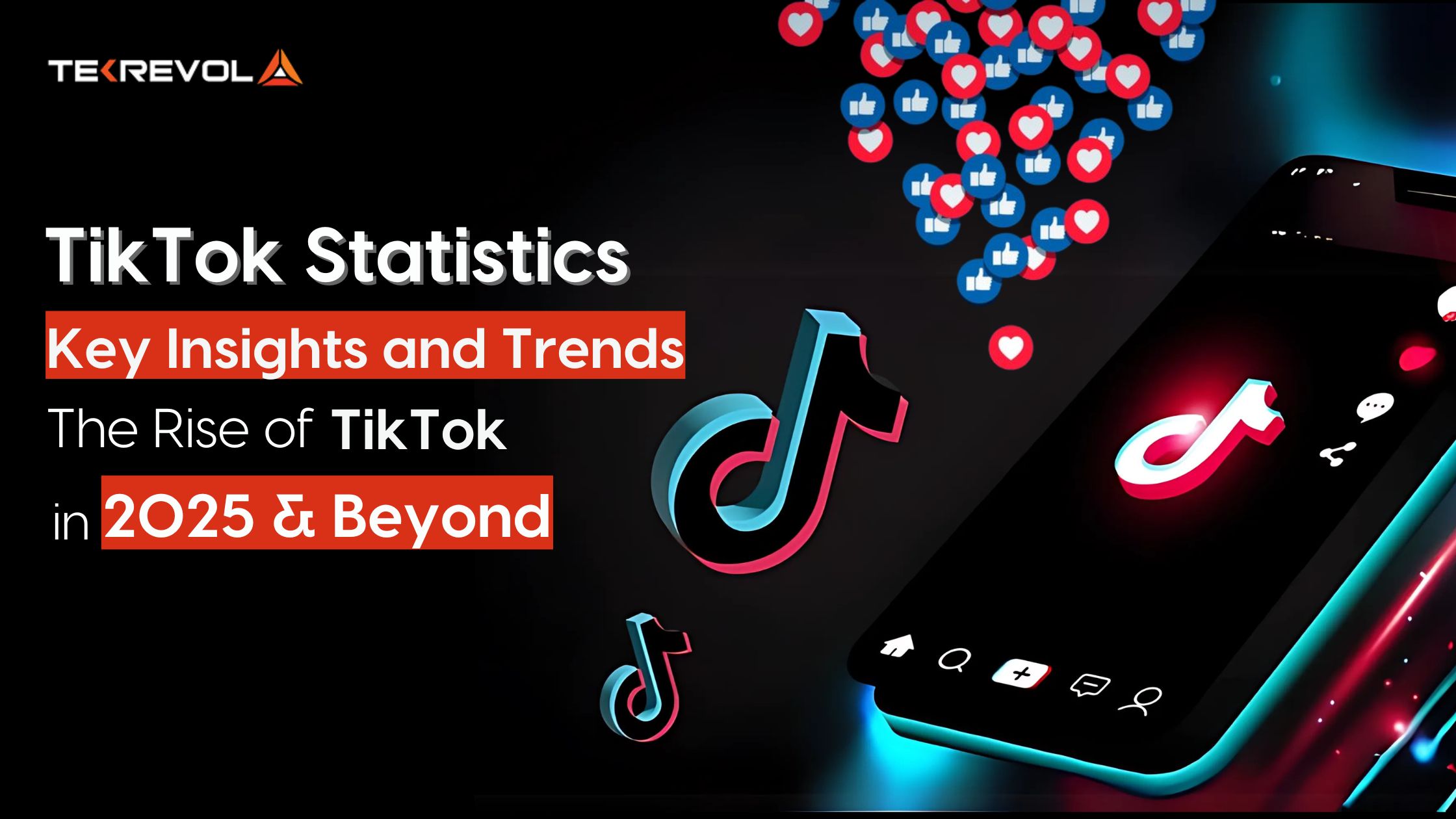Virtual Reality (VR) and Augmented Reality (AR) continue to be driving forces behind innovation and growth for businesses.
This technological duo has been making waves across industries by revolutionizing the way businesses operate, connect with their customers, and achieve their goals.
While still in its infancy, it is estimated that both AR and VR will surpass 100 million users worldwide by 2027. Now what this technology can do in its full potential, no one knows yet.
But looking at the statistics, it is evident that organizations adopting AR VR app development services to create immersive experiences for their users will excel in the near future.
From healthcare to traveling and hospitality, AR and VR are contributing to all major industries with their game-changing applications.
Now whether you’re a business owner, an entrepreneur, a marketer, or you’re simply curious about the future of AR VR development services, this guide will help you understand how AR and VR technology is supporting businesses in 2024.
In this blog, we will dive deeper into the realm of AR and VR technology to explore how they are supporting businesses in today’s world.
So without any further ado, let’s get started!
Successful Businesses Implementing AR and VR Technology to Enhance Customer Experience
Here are some of the renowned names in the business world who use AR and VR technology to enhance customer experience:

IKEA
IKEA, the Swedish multinational furniture and home furnishings retailer, is one of the most notable companies that has successfully implemented AR (Augmented Reality) and VR (Virtual Reality) technology in its business operations.
Known for its innovative approach to retail, IKEA has embraced these emerging technologies to enhance the shopping experience for its customers.
One of IKEA’s most prominent ventures into AR is the IKEA Place app, which was launched in 2017. This app allows users to virtually place furniture and home decor items within their living spaces using their smartphones or tablets.
By utilizing the device’s camera and AR technology, the app can accurately measure the dimensions of the room and then overlay virtual IKEA products in real time.
Customers can see how a particular piece of furniture would look and fit in their homes before making a purchase, eliminating any doubts about size, style, or color compatibility.
Nike
Nike, the world-famous sportswear and athletic footwear brand, has been at the forefront of using Augmented Reality (AR) and Virtual Reality (VR) technology to enhance various aspects of its business.
As a company known for innovation and pushing the boundaries of sports performance, Nike has leveraged AR and VR to create immersive and engaging experiences for its customers and athletes.
Nike Fit is an AR-powered feature within the Nike app that was introduced in 2019. It allows customers to find their perfect shoe size using their smartphone’s camera.
By scanning their feet, the app generates precise measurements, taking into account factors such as foot shape and size. This information is then used to recommend the most suitable shoe size for a particular Nike model.
With Nike Fit, customers can confidently make online purchases, reducing the likelihood of size-related returns and improving overall customer satisfaction.
Gucci
Gucci, the Italian luxury fashion brand, is one of the prominent names in the business world that has embraced AR (Augmented Reality) and VR (Virtual Reality) technology to enhance various aspects of its brand, marketing, and customer experience.
Known for its high-end fashion products, Gucci has leveraged these emerging technologies to create immersive and innovative experiences for its customers.
Gucci introduced an AR-based “Sneaker Try-On” feature in its app, allowing customers to virtually try on their desired sneakers before making a purchase.
Using the smartphone’s camera, the AR technology superimposes the selected Gucci sneakers onto the customer’s feet in real time, providing an interactive and realistic way to see how the shoes would look and fit.
This feature enhances the online shopping experience, empowering customers to make more confident purchasing decisions and reducing the likelihood of returns.
Amazon
Amazon, the multinational technology giant, and the world’s largest online retailer, has been actively incorporating AR (Augmented Reality) and VR (Virtual Reality) technology into various aspects of its business to enhance customer experiences and improve operational efficiency.
Amazon has embraced AR technology to enhance the online shopping experience for its customers. With features like “AR View” in its mobile app, customers can virtually place products, such as furniture or electronics, in their physical space to see how they would look before making a purchase.
This functionality helps customers make informed decisions and reduces the likelihood of returns, as they can better visualize how the products will fit in their homes.
Sephora
Sephora, the leading global beauty retailer, is a prime example of a successful business that has effectively integrated AR (Augmented Reality) and VR (Virtual Reality) technology to enhance the beauty shopping experience for its customers.
Sephora has implemented AR-powered virtual try-on features on its mobile app and website. Customers can use their smartphone’s camera to try on various makeup products virtually, such as lipsticks, eyeshadows, and foundation shades.
This AR try-on experience allows customers to see how different beauty products look on their faces in real-time, helping them make more informed purchase decisions without having to visit a physical store.
Virtual try-on minimizes the need for in-store sampling, streamlining the shopping process and increasing convenience for Sephora’s global customer base.
What is AR and VR?

Augmented Reality (AR) and Virtual Reality (VR) are two distinct but related technologies that aim to enhance the user’s perception and interaction with the digital world.
The differences come down to the devices you use and the experience itself: AR uses a real-world setting, while VR is completely virtual.
Both, AR and VR, fall under the umbrella of immersive technology, XR, which stands for Extended Reality.
Now there is also MR or Mixed Reality, which is basically a blended version of AR and VR. It brings together the physical and digital worlds to create an environment where physical and digital objects coexist and interact in real-time.
Augmented Reality (AR)
Augmented Reality or AR enhances the user’s perception and interaction with their surrounding by overlaying digital information like images, videos, and 3D models onto the real-world environment.
You typically need a smartphone, tablet, or specialized AR glasses to display the digital content in real-time.
The AR technology allows users to view and interact with virtual elements while still being aware of their physical environment.
There are many AR applications in various industries like gaming, education, retail, healthcare, and more.
Virtual Reality (VR)
Virtual Reality or VR can immerse a user in a completely simulated digital environment that can be entirely different from the physical world.
By wearing a VR headset, users are transported to a virtual world that can be interactive and responsive to their movements.
The technology aims to make users feel like they are truly “inside” a virtual environment, creating a sense of presence and immersion.
Both AR and VR technologies have unique capabilities that offer exciting possibilities for businesses.
Now, let’s navigate to the next section to get insights into the 10 game-changing AR/VR trends that are reshaping businesses.
- Step into the Future: Experience AR and VR like Never Before!
- Our team of experts can create immersive and unforgettable experiences for your business.
10 Game-Changing AR/VR Trends Reshaping Businesses
Here are the 10 game-changing AR/VR trends that describe why you should implement this technology for your business operations:
Dive into More Immersive Experiences
You’re suddenly transported to a new world after putting on a VR headset.
The technology allows users to completely immerse themselves in a virtual world, forgetting where they really are. Imagine interacting with virtual objects as if they were right before you.
While this was only limited to gaming, it is now taking businesses by storm. You can just step into a virtual training session or design your room in a virtual environment before actually setting it up.
Tailored Training Experiences
The one-size-fits-all approach and mundane training experiences can bore anyone. AR and VR technology can bring personalized training experiences for employees of any business.
This will allow businesses to empower their workforce with practical skills including tailored training experiences for every individual.
Organizations can simulate real-world scenarios and provide their employees the hands-on experiences in a safe and controlled environment.
Some of the examples that are being used in the world include the simulation of complex machinery, sensitive medical operations, and pilot training.
And it is not even that hard to get your hands on a mobile app development company that excels in creating projects in AR and VR for your organization.
Amping Up Teamwork from Anywhere
Physical proximity is not a requirement for effective teamwork anymore. One of the things that the pandemic has shown us is that remote work can be just as productive as in-person work.
However, endless email threads and boring Zoom meetings can kill creativity and engagement. AR and VR technology defies geographical boundaries and brings people together in a shared virtual environment.
Organizations can conduct virtual project meetings, brainstorming sessions, or training workshops to amp up the collaboration game from anywhere in the world.
The distance becomes irrelevant when all the participants are immersed in a shared virtual environment, solving problems and making decisions that go beyond traditional methods.
Virtual Events: The New Way to Party
AR and VR technology is allowing businesses to organize events in virtual spaces, offering audiences an immersive and unforgettable experience.
During the COVID-19 pandemic, many organizers had to face difficulties because of last-minute cancellations of events.
However, AR and VR technology allows audiences to attend a concert, conference, or social gathering from the comfort of their own home.
You can dance alongside your favorite artist, engage with professionals around the world, or celebrate special occasions with your friends and family in a virtual environment. You can even customize your avatar or explore different virtual venues.
Moreover, one of the advantages that virtual events have is that you don’t have to worry about travel costs, accommodation, or venue capacity. With AR/VR technology, you can join your favorite virtual event from anywhere in the world.
And if you’re a business owner wanting to create your dream project then you’re only one step behind.
All you need to do is contact a legit on-demand app development company that specializes in AR VR app development services and you’re good to go!
Making Product Design Ever Cooler
Businesses are used to the traditional methods of relying solely on sketches and 2D renderings to visualize their designs.
However, they can get a better understanding of their product with the use of AR and VR. The technology allows you to easily shape or design a product right before your eyes even before manufacturing it.
The advancement of this technology even allows the users to interact or test the product in a virtual environment that feels as real as the physical world.
The use of AR and VR technology also allows designers, engineers, and stakeholders to work together in a shared space to collaborate in real time and make instant design iterations.
This will enable the teams to accelerate the entire product development process.
Boosting the Marketing Game
AR and VR can revolutionize the way businesses engage with their customers and boost their marketing game to new heights.
Businesses can create interactive and immersive marketing campaigns to grab the attention of audiences. Organizations can build 3D virtual showrooms for audiences to test their product and allow them to explore virtual spaces.
The magic of virtual reality and augmented reality flips the script by transforming the audience into becoming active participants rather than mere observers.
So if you want your business to grow by adding a seasoning of virtual reality and augmented reality then all you need to do is book a call with one of the experts in AR VR development services in the industry.
You can even get in touch with a mobile app development company in Dallas, Houston, or any other state of the US where you’re residing to physically convey your requirements.
Supercharging Customer Service
Solving a problem of a customer is the best way to get more customers. AR and VR technology can provide virtual assistance that goes beyond the traditional phone or chat support.
Businesses can supercharge their customer service experience by interacting with their customers and solving problems in a virtual space.
Organizations can provide a virtual assistant that can guide the user through complex processes.
The assistant can further help the customer by demonstrating product features or troubleshooting issues in real time.
Leveling Up Data Visualization
Static charts and spreadsheets can be mundane and audiences cannot properly break down data if they’re not explaining themselves.
AR and VR can help businesses in creating interactive and informative data visualizations. It can provide a unique platform to unlock meaningful insights from complex data by visualizing it in an immersive environment.
The AR and VR technology enables you to feel like you’re playing in a data playground where you can dive deeper into datasets with just a flick of your virtual hand.
Broadening Business Accessibility
AR and VR technology contributes to making this world without limits. It offers solutions that go beyond physical barriers, allowing people with disabilities to engage, interact, and participate fully in the business world.
Organizations can provide immersive experiences for the visually impaired or create accessible virtual environments for handicapped personnel.
It can help them in contributing to businesses regardless of mobility constraints or geographical location.
Moreover, AR and VR can further broaden business accessibility by providing intuitive and user-friendly interfaces.
By the use of gestures and voice commands, AR and VR allow customers to interact with the content in a more natural way.
Innovating Manufacturing Processes
The risks of errors can be reduced in manufacturing processes if businesses start using AR and VR in their operations.
They would easily be able to shape products before manufacturing them in the real world. This technology has the ability to create accurate visualization and simulation of products with precision.
They can easily shape their products before even manufacturing them in the real world. AR and VR technology allows the visualization, simulation, and optimization of a product with precision.
And all of this is possible because of the free hand that the manufacturers have while designing. They can create prototypes and iterate in virtual spaces to create error-free products.
Moreover, it is also possible to simulate the behavior of products by testing them in different scenarios. This allows manufacturers to identify flaws and refine their designs with minimal cost.
Applications of AR and VR in Businesses
The applications of AR and VR are revolutionizing the business impact in various industries.
Virtual and augmented realities help develop new products and services by making them more appealing to customers.
We’ve seen organizations taking an interest in building a VR game for the virtual training of their employees and healthcare professionals in creating simulations of medical surgeries to train their interns in a safe and controlled environment.
Moreover, AR and VR technology enhances the quality-of-service experience and creates a better connection between people and things by improving customer and employee interaction.
Here are the many applications of AR and VR in businesses:
Healthcare
AR and VR can help surgeons immerse themselves in virtual environments to practice procedures before stepping foot in the operation room.
Moreover, patients can take advantage of virtual consultations which can eliminate the need for physical visits.
The technology is also contributing to the education sector where students can engage in realistic simulations to practice critical procedures in safe and controlled environments.
Hence, if you want to get your dream healthcare application built by us, give us a call today. Our team of tech experts will help you out, and give quality-enriched, value-added healthcare app development services.
Marketing and Advertising
It is no mystery that the attention span of humans is dwindling over time. According to Wyzowl’s research, it has been identified that the average attention span of a human decreased from 12 seconds to 8.25 seconds in just 15 years.

Now what is the meaning of this for a marketer? Well, it’s simple. This means that marketing and advertising agencies or businesses will need to adapt to this by creating content in a way that can help their brand stand out in the crowd.
One of the solutions for this was AR and VR technologies, which helped the marketing domain in creating interactive and captivating experiences for its user base.
This technology delivered the wow factor in marketing campaigns which was lost a long time ago for some industries.
Virtual Training
AR and VR technologies are revolutionizing the way businesses conduct their training activities.
Organizations are eliminating the approach of traditional classrooms and adapting to the new trend of virtual learning.
This allows participants to learn in immersive virtual environments where a user can visually interact with an instructor or collaborate with classmates around the world.
Retail
If you’re not a person who likes to shop and try every clothing before purchasing then Virtual Reality shopping is the solution for you.
This technology has the ability to bring the fitting room to your fingertips where you can try on different clothing or accessories.
Customers can even place furniture in their rooms using AR technology to see if it looks good or not.
Moreover, virtual showrooms are slowly taking over to replace traditional retail stores. The implementation of this new technology can allow shoppers to see retail items in 3D and even try them on.
Real Estate
AR and VR technology can help people in taking a tour of their dream house without setting foot in it. You are able to explore every nook and corner of the house as if you’re physically there.
Moreover, advancements in this technology can even allow customers to customize their space by rearranging furniture, carrying out renovations, and experimenting with interior designs. IKEA Place is one of the best AR apps to explain the application of VR/AR in real estate.
Furthermore, AR and VR technology is also helping real estate agents in saving time, particularly for those properties which are located in far-off areas.
According to a study, it is estimated that approx. 1.4 million real estate agents are already using VR technology to avail benefits like saving money, reaching global clients, and improving onboarding time.
Traveling and Hospitality
AR and VR technology is helping traveling businesses cater to the needs of their customers by allowing them to explore destinations from the comfort of their homes.
Audiences can virtually stroll around bustling city streets or breathtaking landscapes before booking their vacation tickets.
Moreover, this technology can also enhance the hotel experience by adding the convenience factor.
This means you can just scan an item in your hotel room to receive interactive information about it. It’s like you have a virtual concierge right at your fingertips.
Business Advantages of AR and VR
Here are some of the business advantages of AR and VR:
Enhanced Workplace Connectivity
AR and VR technology can bring teams closer regardless of where they’re living. It introduced the new fashion of how collaboration with your team can still be lifelike in a virtual environment.
While the introduction of remote work during the COVID-19 pandemic unleashed flexible methods to work jobs without commuting to work, it also gave birth to the disengagement of employees from work.
According to National Public Radio’s Employee Engagement Gallup survey conducted in 2022, only 32% of workers were engaged with their work compared with 36% in 2020.

So what was the reason for this? Well, we’re hardwired to need human connection and the reliance on video calling can lead to feelings of loneliness and isolation. This can have an impact on our work.
However, with the use of virtual reality, you can work in an immersive virtual room where you can see and interact with your colleagues in a lifelike environment.
Unforgettable Product Presentations
Businesses can only stand out in a market if they give their customers unforgettable product demos and presentations.
AR and VR technology can help businesses showcase their product in a captivating way. Users can easily watch the products come to life in virtual showrooms with 3D functionality.
Audiences can also customize products in real-time which can allow them to see variations and personalization options before they make a purchasing decision.
Embracing Sustainable Work Methods
The negative impact on the environment will be less if there are few people traveling for business purposes.
Virtual conferencing can cut down the carbon footprint by 94% and energy use by 90% (Nature Journal). This means VR technology can contribute to building an eco-friendly responsible business landscape.
Businesses can easily operate with virtual workspaces which will reduce the need for physical offices. This can also minimize resource consumption for any organization.
AR and VR technology can also provide alternatives to extensive travel, eliminating face-to-face meetings and business trips. It can also offer sustainable solutions for training and education through in-person virtual sessions and virtual workshops.
Engaging Training and Onboarding Experiences
Virtual training is one of the most popular uses of VR technology. It offers a safe and controlled environment for employees to practice their skills and solve challenging scenario-based problems.
You’ll be able to totally immerse yourself in an environment where you can carry out different tasks like customer interaction and technical support without the fear of real-world consequences.
Moreover, employees can also hone their skills with interactive quizzes and gamified challenges using 3D models and simulations.
Additionally, the traditional virtual onboarding methods can be full of errors where a recruiter doesn’t get much from the interviewee.
VR technology can allow recruiters to get a clear understanding of the talent their testing. In this way, the candidate is also getting a chance to secure a job in the least time by showcasing the skills practically in a simulation model.
Meaningful Cost Savings
While face-to-face meetings have their advantages, they can also be surprisingly expensive.
According to Statista’s 2019 research, the average expense per attendee to business meetings was 782 U.S. dollars per day, which makes up a whopping amount.
So do we have a solution for this? Certainly! AR and VR technology can significantly cut down travel expenses through virtual client meetings, conferences, and training sessions.
There will be no need for costly flights, accommodation, and transportation as you can be present in a room without physically being there.
- Create memorable experiences by elevating your App with cutting-edge AR and VR features!
- Our team of experts can bring your dream project to life!
What is the Future of AR and VR?
Augmented Reality (AR) and Virtual Reality (VR) have become essential tools in transforming business operations.
They have reshaped customer experiences in many sectors including healthcare, retail, traveling and hospitality, marketing and advertising, and real estate.
AR and VR combined were worth $12 billion in 2020 with a massive annual growth rate of 54%.
With these numbers, it is estimated that the industry can grow to a projected valuation of $72.8 billion by 2024.
Winner of the AR vs VR Race
If we talk about the comparison between AR and VR, then AR clearly wins the race.
That’s because Virtual Reality is fully immersive, which requires a headset and in most cases, controllers for interacting with the environment. And because of these extensive hardware requirements, it is impractical for retail use.
On the other hand, AR allows customers to overlay computer-generated images onto real-world views. So to access AR-based applications, all you need is a smartphone, which the majority of shoppers already own.
Nonetheless, both technologies are booming and it is clear that we’ll be witnessing a transformative era where AR and VR will shape the way we work.

 3624 Views
3624 Views July 15, 2024
July 15, 2024









